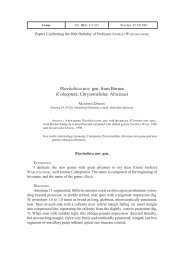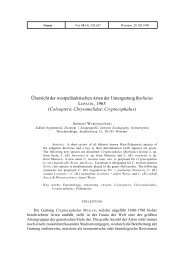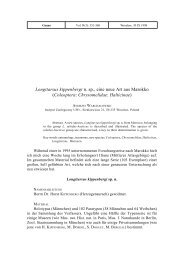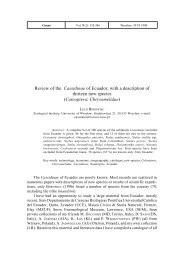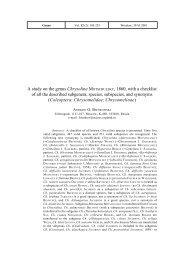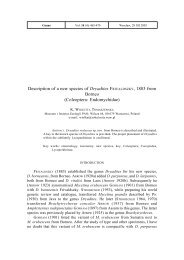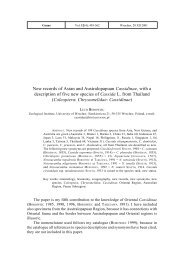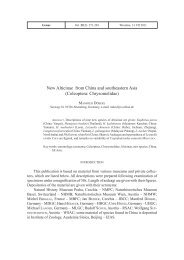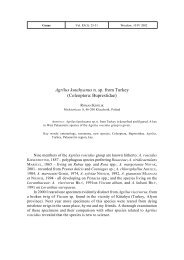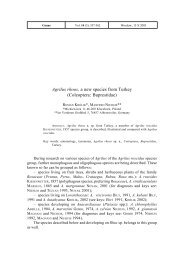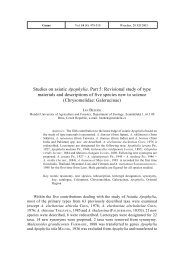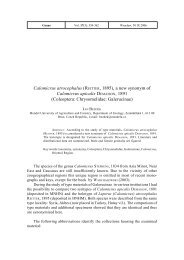Revisional study on African Apophylia. Part 1.
Revisional study on African Apophylia. Part 1.
Revisional study on African Apophylia. Part 1.
Create successful ePaper yourself
Turn your PDF publications into a flip-book with our unique Google optimized e-Paper software.
104 JAN BEZDÌK<br />
COMMENTS<br />
Eight specimens from the type series of A. sericea were found (7 syntypes in<br />
MRAC, 1 syntype in ISNB). One of the male syntypes from MRAC is designated<br />
here as the lectotype. A. sericea LABOISSIÈRE, 1922 proved to be preoccupied by<br />
A. sericea (FABRICIUS, 1798) and was replaced by LABOISSIÈRE (1925) himself as<br />
A. holosericea.<br />
The descripti<strong>on</strong> of A. c<strong>on</strong>sociata is very brief in the identificati<strong>on</strong> key and was<br />
possibly omitted within the other descripti<strong>on</strong>s (LABOISSIÈRE, 1922). I have found<br />
<strong>on</strong>e male in ISNB whose label data fits the above short descripti<strong>on</strong>. The red label<br />
“Holotype“ was very probably added by the subsequent curator. The sec<strong>on</strong>d<br />
specimen deposited in MRAC is not a type specimen and it bears LABOISSIÈRE´s<br />
identificati<strong>on</strong> label of the year 1940. Because LABOISSIÈRE did not state the number<br />
of available specimens, I decided to designate here the male from ISNB as the<br />
lectotype.<br />
The examinati<strong>on</strong> of aedeagi of the primary types of both species showed no<br />
difference in the structure of male genitalia. LABOISSIÈRE (1922) distinguished<br />
A. c<strong>on</strong>sociata and A. sericea by the structure of elytral hairs which are recumbent<br />
and silk-like in A. sericea. The lectotype of A. c<strong>on</strong>sociata is nothing but a worn<br />
specimen of the same species. Both A. c<strong>on</strong>sociata and A. sericea were described<br />
in the same paper. According to ICZN (24.2.2.), the nomenclatorial priority is<br />
fixed by the first revising author. Due to the very short descripti<strong>on</strong> and of the <strong>on</strong>ly<br />
known type specimen of A. c<strong>on</strong>sociata, I decided to apply A. sericea as the senior<br />
syn<strong>on</strong>ym. A. c<strong>on</strong>sociata is c<strong>on</strong>sidered a new syn<strong>on</strong>ym of A. sericea. Due to the<br />
subsequent renaming the valid name of this species is A. holosericea.<br />
<strong>Apophylia</strong> maynei LABOISSIÈRE, 1922<br />
<strong>Apophylia</strong> Maynéi LABOISSIÈRE, 1922: Rev. Zool. Afr., 10: 244 (key), 255-256 (sep. 156 (key), 167-<br />
168) (Type locality: Albertville).<br />
<strong>Apophylia</strong> Maynei: LABOISSIÈRE, 1925: 58.<br />
<strong>Apophylia</strong> maynei: WILCOX, 1971: 146.<br />
TYPE MATERIAL EXAMINED<br />
Lectotype (male), designated here, and 2 paralectotypes (males), labelled:<br />
“LECTOTYPUS [or PARALECTOTYPUS, resp., red label, p] // Type [w, h, red<br />
letters] // MUSÉE DU CONGO Albertville XII-1918 R. Mayné [w, p] // R. DÉT.<br />
[p] D [h] 728 [w, p] // <strong>Apophylia</strong> Maynei m [h] V. Laboissière – Dét. [w, p]“ (in<br />
MRAC); 2 paralectotypes (males), labelled: “PARA-LECTOTYPUS [red label,<br />
p] // MUSÉE DU CONGO Albertville XII-1918 R. Mayné [w, p] // R. DÉT. [p] D<br />
[h] 728 [w, p] // <strong>Apophylia</strong> Maynei m [h] V. Laboissière – Dét. [w, p]“ (in<br />
MRAC); paralectotype (male), labelled: “m [w, p] // Coll. R. I. Sc. N. B. C<strong>on</strong>go<br />
belge [blue label <strong>on</strong> which three following labels are stuck, p] // Albertville [w, p]<br />
// XII-1918 [w, p] // R. Mayné [w, p] // <strong>Apophylia</strong> Maynei m 1922 [h] V.<br />
Laboissière – Dét. [w, p] // Para-type [red label, p]“ (in ISNB). The specimens are



